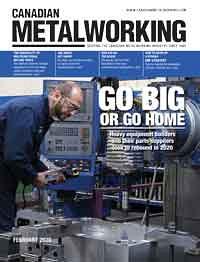Development Manager, U.K. and Ireland
- FMA
- The Fabricator
- FABTECH
- Canadian Metalworking
Fixing fastener corrosion
Fighting corrosion reduces costs, lengthens product life, helps environment
- By Nimeka de Silva and Patrik Lundström Törnquist
- February 24, 2020
- Article
- Management
Metallic corrosion is the result of electrochemical interaction between a metal and substances present within its operating environment. It results in degradation of that material, to the point where it is no longer mechanically or structurally sound.
Corrosion presents a formidable global challenge. It affects many everyday products and almost all infrastructure through increased maintenance, shorter product life cycles, and more resources.
The economic and environmental impact is significant, and manufacturers should take notice.
The “International Measures of Prevention, Application, and Economics of Corrosion Technology” (IMPACT) study by NACE International, a not-for-profit organization for the corrosion control industry, estimates that the global cost of corrosion is US$2.5 trillion annually – equivalent to around 3 per cent of global GDP in 2018. However, it also estimates that existing corrosion control practices could save 15 to 35 per cent of the cost of corrosion, equating to between US$375 billion and US$875 billion globally each year.
Environmental impact
The consequences of corrosion on the environment are not included in the NACE study, but they are increasingly important. In response to greater interest in issues related to environmental impact and sustainability, engineers now design products and infrastructure that can minimize negative environmental and societal impact. Sustainability in design, optimization of a product’s life cycle, minimization of maintenance requirements, and end-of-life upcycling/recycling are all becoming an important part of product performance, quality, and overall cost.
In the future it is very likely that we will see even more burden placed on manufacturers for part/product end-of-life management, so making early considerations in the design and planning stage will become a more crucial aspect of engineering. Life cycle assessments (LCAs) are becoming ever more important for any product or project from both a customer and regulator perspective.
One way to ease the burden of corrosion is to use pieces during assembly that are more corrosion-resistant.
Stainless steel fasteners, for example, have long been used in corrosive environments, such as within the oil and gas industry, chemical processing, and marine and coastal applications. In recent years stainless steel materials, predominantly austenitic grades A2 (304) and A4 (316), have become more readily available. Now interest in premium stainless steel and high-grade alloy fasteners has really taken off.
In the correct application, they offer improved product performance and reduced maintenance and can help to maximize the product life cycle. Considering total life cycle costs can help manufacturers to achieve significant cost efficiencies over the lifespan of a product, rather than an approach focusing purely on the initial upfront cost.
Particularly in more technical industries where performance, safety, and reliability are all critical factors, engineers are now starting to give more consideration to an ever-increasing range of fastener products and material options available to them in an attempt to design more robust and long-term cost-effective products and infrastructure.
Challenges for engineers
One of the traditional limitations accepted by engineers when considering the use of stainless steel materials is its reduced mechanical strength compared with high-tensile carbon steel. If a combination of high strength and corrosion resistance is required, engineers often resort to the use of high-tensile carbon steel with an additional protective coating.
However, high-tensile carbon steel brings with it the burden of finding a coating suitable for the application and the associated performance, quality, and lifespan for the coating. High-tensile carbon steels are also prone to the risk of hydrogen embrittlement as a result of their manufacturing process. Engineers often express concerns regarding this risk, and careful consideration always should be given during their production.
Enter high-corrosion-resistance stainless steel fasteners. These products combine the corrosion resistance capabilities of different stainless steel material grades with the strength of high-tensile carbon steel.
These fasteners open up new possibilities for design engineers that require a combination of high mechanical performance and corrosion resistance.
Applications for these premium stainless steel fasteners include aerospace, offshore equipment, steel construction, high-end electric bikes, high-pressure applications, fueling systems, and semiconductor manufacturing equipment. Many more applications may follow, to the benefit of not only the owners and users of products and infrastructure – with higher quality, reduced maintenance, and longer lifespans – but also the entire planet with the potential for the more sustainable use of material resources.
Nimeka de Silva is development manager, U.K. and Ireland, and Patrik Lundström Törnquist is managing director for BUMAX®, 46-10-478-44-00, www.bumax-fasteners.com.
About the Authors
subscribe now


Keep up to date with the latest news, events, and technology for all things metal from our pair of monthly magazines written specifically for Canadian manufacturers!
Start Your Free Subscription- Trending Articles
Automating additive manufacturing

CTMA launches another round of Career-Ready program

Collet chuck provides accuracy in small diameter cutting

Sandvik Coromant hosts workforce development event empowering young women in manufacturing

GF Machining Solutions names managing director and head of market region North and Central Americas

- Industry Events
MME Winnipeg
- April 30, 2024
- Winnipeg, ON Canada
CTMA Economic Uncertainty: Helping You Navigate Windsor Seminar
- April 30, 2024
- Windsor, ON Canada
CTMA Economic Uncertainty: Helping You Navigate Kitchener Seminar
- May 2, 2024
- Kitchener, ON Canada
Automate 2024
- May 6 - 9, 2024
- Chicago, IL
ANCA Open House
- May 7 - 8, 2024
- Wixom, MI
















